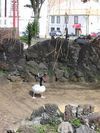Genus Cygnus

Black Swan - Black swans were first seen by Europeans in 1697, when Willem de Vlamingh's expedition explored the Swan River, Western Australia.
Bugler swan - Males typically measure from 145 to 163 centimetres and weigh 11.8 kilograms ; females typically range from 139 to 150 centimetres and weigh 10 kilograms . The average wingspan is 2.03 metres . It is rivaled in size among waterfowl only by the introduced Mute Swan, which is native to Eurasia, but the Trumpeter usually is longer-bodied. Exceptionally large male Trumpeters can reach a length of 183 centimetres , a wingspan of 3 metres and a weight of 17.2 kilograms . The Trumpeter Swan is closely related to the Whooper Swan of Eurasia, and even has been considered the same species by some authorities.
Whistling Swan - C. c. bewickii , Bewick's Swan C. c. columbianus , Whistling Swan
Whooper Swan - The Whooper Swan is similar in appearance to the Bewick's Swan. However, it is larger, at a length of 140-160 cm , a wingspan of 205-275 cm and a weight range of 8–20 kg . It has a more angular head shape and a more variable bill pattern that always shows more yellow than black .
Black-necked Swan - The smallest member in its genus, it is found in freshwater marshes, lagoon and lake shores in southern South America. The Black-necked Swan breeds in Zona Sur, Patagonia, Tierra del Fuego and on the Falkland Islands. In the austral winter, this species migrates northwards to Paraguay and southern Brazil. The Laguna Blanca National Park in Argentina is a protected home of this swan. The wetlands created by the Great Chilean Earthquake like Carlos Anwandter Nature Sanctuary in Cruces River have become important population centers for the Black-necked Swan.
Mute Swan - The Mute Swan was first formally described by the German naturalist Johann Friedrich Gmelin as Anas olor in 1789, and was transferred by Johann Matthäus Bechstein to the new genus Cygnus in 1803. It is the type species of the genus Cygnus. The synonym Sthenelides olor has occasionally been used in the past.






